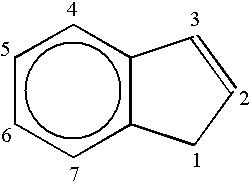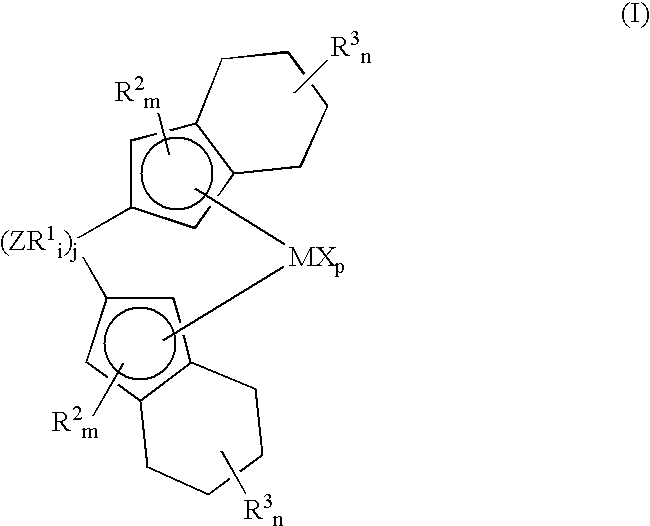Bis(tetrahydro-indenyl) metallocenes as olefin-polymerization-catalyst
a technology of olefin and metallocene, which is applied in the direction of catalyst activation/preparation, chemical/physical processes, group 4/14 element organic compounds, etc., can solve problems such as unsatisfactory molecular weight of products
- Summary
- Abstract
- Description
- Claims
- Application Information
AI Technical Summary
Benefits of technology
Problems solved by technology
Method used
Image
Examples
examples 3 and 4
Ethylene Homopolymerization
A 1 L stainless-steel autoclave, equipped with magnetic stirrer, temperature indicator and feeding line for the ethylene, was thermostatted with H.sub.2 O / steam and purified by purging with ethylene at 80.degree. C. Under ethylene purge, 500 mL of n-hexane and TIBA (2 mmol in Ex. 3; 1 mmol in Ex. 4) were added; the temperature was brought to 80.degree. C. and the reactor was vented to remove residual nitrogen. The reactor was then pressurized with ethylene up to 11 bar-a. The catalyst solution, comprising the catalyst and cocatalyst reported in Table 2A, was injected into the autoclave with ethylene overpressure and the ethylene partial pressure was stabilized (Ptot=10 bar-g). Polymerization was carried out at 80.degree. C. for 1 hour, by maintaining a constant ethylene partial pressure of 9.6 bar. The polymerization was interrupted by degassing unreacted ethylene; after filtration and drying in vacuum at 60.degree. C.
The polymerization conditions and resu...
examples 7-10
Ethylene / Propylene Copolymerization
Copolymerization reactions were carried out in a 1-L jacketed stainless-steel autoclave, as described in Examples 1-2. AliBu.sub.3 (1 mmol in hexane) and propylene (530 g, 1 L total volume at 60.degree. C.) were charged and thermostatted at 55.degree. C.; the amounts of catalyst and cocatalyst reported in Table 3 were injected into the autoclave, by means of ethylene pressure (using the amount of ethylene required to achieve the bath composition shown in Table 3), through the stainless-steel vial. The temperature was rapidly raised to 50.degree. C. and the polymerization was carried out for 1 hour, at constant temperature and monomer composition, by feeding the mixture of ethylene and propylene reported in Table 3.
The polymerization was stopped with CO; the unreacted monomers were vented and the obtained copolymer was dried under reduced pressure, at 60.degree. C.
The polymerization conditions and the characterization data of the obtained copolymers...
example 11
Ethylene Homopolymerization
The following polymerization procedure, similar to the one described in examples 3 and 4 was followed: a 1 L stainless-steel autoclave equipped with magnetic stirrer, temperature indicator and feeding line for the ethylene, was thermostatted with H.sub.2 O / steam and purified by purging with ethylene at 80.degree. C. Under ethylene purge, 500 mL of n-hexane and 1 mmol of TIBA were charged into the reactor; the temperature was brought to 80.degree. C. and the reactor was vented to remove residual nitrogen. The reactor was then pressurized with ethylene up to 11 bar-a. The catalyst solution, comprising the catalyst and cocatalyst reported in Table 2A, was injected into the autoclave with ethylene overpressure and the ethylene partial pressure was stabilized (Ptot=10 bar-g). Polymerization was carried out at 80.degree. C. for 1 hour, by maintaining a constant ethylene partial pressure. The polymerization was interrupted by degassing unreacted ethylene; after f...
PUM
| Property | Measurement | Unit |
|---|---|---|
| Fraction | aaaaa | aaaaa |
| Fraction | aaaaa | aaaaa |
| Fraction | aaaaa | aaaaa |
Abstract
Description
Claims
Application Information
 Login to View More
Login to View More - R&D
- Intellectual Property
- Life Sciences
- Materials
- Tech Scout
- Unparalleled Data Quality
- Higher Quality Content
- 60% Fewer Hallucinations
Browse by: Latest US Patents, China's latest patents, Technical Efficacy Thesaurus, Application Domain, Technology Topic, Popular Technical Reports.
© 2025 PatSnap. All rights reserved.Legal|Privacy policy|Modern Slavery Act Transparency Statement|Sitemap|About US| Contact US: help@patsnap.com



